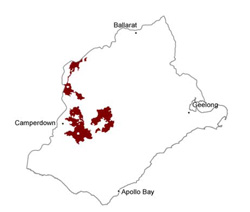6.1.2 Stony rises of the Volcanic Western Plains
|
The stony rises represent the most recent volcanic activity, the most prominent of which forms the platform from which the Mount Porndon (289 m) scoria cones rise. This feature has been dated as 59 000 years old, placing it among the youngest landforms in Australia (Stone et al. 1977). |  |
Soil-landform unit | Original unit ID | Unit description | Area (km2) |
32 | Lava plain with stony rises (e.g. Derrinallum) | 297 | |
127 | Undulating stony rises (e.g. Stoneyford) | 171 | |
131 | Undulating basalt plains (e.g. Dreeite) | 210 |


